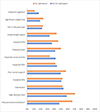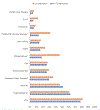Intraoperative haemodynamics and postoperative intensive care unit admission in older patients with cancer
- PMID: 34134558
- PMCID: PMC11251495
- DOI: 10.1177/17504589211012351
Intraoperative haemodynamics and postoperative intensive care unit admission in older patients with cancer
Abstract
Purpose: Research on the impact of various intraoperative haemodynamic variables on the incidence of postoperative ICU admission among older patients with cancer is limited. In this study, the relationship between intraoperative haemodynamic status and postoperative intensive care unit admission among older patients with cancer is explored.
Methods: Patients aged ≥75 who underwent elective oncologic surgery lasting ≥120min were analysed. Chi-squared and t-tests were used to assess the associations between intraoperative variables with postoperative intensive care unit admission. Multivariable regressions were used to analyse potential predict risk factors for postoperative intensive care unit admission.
Results: Out of 994 patients, 48 (4.8%) were admitted to the intensive care unit within 30 days following surgery. Intensive care unit admission was associated with the presence of ≥4 comorbid conditions, intraoperative blood loss ≥100mL, and intraoperative tachycardia and hypertensive urgency. On multivariable analysis, operation time ≥240min (Odds Ratio [OR] = 2.29, p = 0.01), and each minute spent with intraoperative hypertensive urgency (OR = 1.06, p = 0.01) or tachycardia (OR = 1.01, p = 0.002) were associated with postoperative intensive care unit admission.
Conclusion: Intraoperative hypertensive urgency and tachycardia were associated with postoperative intensive care unit admission in older patients undergoing cancer surgery.
Keywords: Geriatrics; Haemodynamics; Hypertensive urgency; Intensive care unit admission; Perioperative outcome; Tachycardia.
Conflict of interest statement
Figures


References
-
- Ahuja K and Charap MH 2010. Management of perioperative hypertensive urgencies with parenteral medications. Journal of Hospital Medicine 5 (2) E11–16 - PubMed
-
- Carpenter GI 2005. Aging in the United Kingdom and Europe—A Snapshot of the Future? Journal of the American Geriatrics Society 53 (9s) S310–S313 - PubMed
-
- Desai RG, Muntazar M and Goldberg ME 2009. Strategies for managing perioperative hypertension. Current Hypertension Reports 11 (3) 173–177 - PubMed
Publication types
MeSH terms
Grants and funding
LinkOut - more resources
Full Text Sources
Medical

